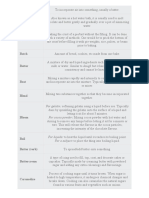0 ratings0% found this document useful (0 votes)
208 viewsModule One 2basic Baking Principles
The chapter discusses basic baking principles including the three phases of mixing: blending ingredients, forming dough, and developing dough. During mixing, air cells are formed, hydration occurs, and gluten is developed from wheat proteins combining with water. Gluten development can be controlled through flour selection, fats, water, mixing methods, leavening, temperature, and other ingredients. The baking process involves melting fats, gas expansion and formation, protein coagulation, starch gelatinization, moisture and gas escape, crust formation, and cooling where staling later occurs.
Uploaded by
Ihsan BadshaCopyright
© © All Rights Reserved
Available Formats
Download as PPTX, PDF, TXT or read online on Scribd
0 ratings0% found this document useful (0 votes)
208 viewsModule One 2basic Baking Principles
The chapter discusses basic baking principles including the three phases of mixing: blending ingredients, forming dough, and developing dough. During mixing, air cells are formed, hydration occurs, and gluten is developed from wheat proteins combining with water. Gluten development can be controlled through flour selection, fats, water, mixing methods, leavening, temperature, and other ingredients. The baking process involves melting fats, gas expansion and formation, protein coagulation, starch gelatinization, moisture and gas escape, crust formation, and cooling where staling later occurs.
Uploaded by
Ihsan BadshaCopyright
© © All Rights Reserved
Available Formats
Download as PPTX, PDF, TXT or read online on Scribd
You are on page 1/ 9
Chapter 5
Basic Baking Principles
Mr. Vasanthan Sigamany, Associate Professor, WGSHA
Chapter 5
Basic Baking Principles
Mixing and Gluten Development
Three phases of the Basic Mixing Process
1. Blending the ingredients.
2. Forming the dough.
3. Developing the dough.
Mr. Vasanthan Sigamany, Associate Professor, WGSHA
Chapter 5
Basic Baking Principles
Processes That Occur During Mixing
1. Air cell formation
2. Hydration: the process of absorbing water
3. Gluten development
Mr. Vasanthan Sigamany, Associate Professor, WGSHA
Chapter 5
Basic Baking Principles
Controlling Gluten Development
• Glutenin and gliadin are two proteins found in wheat flour.
When these two proteins combine with water, they form a
stretchable substance called gluten.
• Glutenin and gliadin are two proteins found in wheat flour.
When these two proteins combine with water, they form a
stretchable substance called gluten.
Mr. Vasanthan Sigamany, Associate Professor, WGSHA
Chapter 5
Basic Baking Principles
Methods for Adjusting Gluten Development
Gluten development can be controlled through:
• Selection of flours.
• Fat and other tenderizers.
• Any fat used in baking is called a shortening because it
shortens the gluten strands.
• Water.
Mr. Vasanthan Sigamany, Associate Professor, WGSHA
Chapter 5
Basic Baking Principles
Methods for Adjusting Gluten Development
Gluten development can be controlled through:
• Mixing Methods
• Proteins are hydrated.
• Air is mixed in the dough.
• Gluten strands are developed by mixing.
• Leavening
• Expansion of air cells stretches the gluten and strengthens it.
• Leavening also tenderizes the product by making cell walls
thinner.
• Temperature
• Gluten develops more at a warm room temperature than at a
cold temperature.
Mr. Vasanthan Sigamany, Associate Professor, WGSHA
Chapter 5
Basic Baking Principles
Methods for Adjusting Gluten Development
Other Ingredients and Additives
• Salt: strengthens glutens and controls yeast growth.
• Bran: inhibits gluten development because it prevents
some of the gluten from sticking together.
• Dough conditioners.
• Milk: contains and enzyme that interferes with gluten
development.
Mr. Vasanthan Sigamany, Associate Professor, WGSHA
Chapter 5
Basic Baking Principles
The Baking Process
1. Melting of fats
2. Formation and expansion of gases
3. Killing of yeast and microorganisms
4. Coagulation of proteins
5. Gelatinization of starches
6. Escape of water vapor and other gases
7. Crust formation and browning
Mr. Vasanthan Sigamany, Associate Professor, WGSHA
Chapter 5
Basic Baking Principles
The Baking Process
8. Cooling: starches continue to gelatinize and molecule
bond with each other and become more solid as the
product cools. This process is called starch retrogradation
and causes staling.
9. Staling: the change in texture and aroma of baked goods
due to a change of structure and a loss of moisture.
Mr. Vasanthan Sigamany, Associate Professor, WGSHA
You might also like
- Hourglass Workout Program by Luisagiuliet 276% (21)Hourglass Workout Program by Luisagiuliet 251 pages
- The Hold Me Tight Workbook - Dr. Sue Johnson100% (16)The Hold Me Tight Workbook - Dr. Sue Johnson187 pages
- Read People Like A Book by Patrick King-Edited62% (66)Read People Like A Book by Patrick King-Edited12 pages
- Livingood, Blake - Livingood Daily Your 21-Day Guide To Experience Real Health77% (13)Livingood, Blake - Livingood Daily Your 21-Day Guide To Experience Real Health260 pages
- COSMIC CONSCIOUSNESS OF HUMANITY - PROBLEMS OF NEW COSMOGONY (V.P.Kaznacheev,. Л. V. Trofimov.)94% (212)COSMIC CONSCIOUSNESS OF HUMANITY - PROBLEMS OF NEW COSMOGONY (V.P.Kaznacheev,. Л. V. Trofimov.)212 pages
- Donald Trump & Jeffrey Epstein Rape Lawsuit and Affidavits83% (1016)Donald Trump & Jeffrey Epstein Rape Lawsuit and Affidavits13 pages
- The 36 Questions That Lead To Love - The New York Times94% (34)The 36 Questions That Lead To Love - The New York Times3 pages
- The 36 Questions That Lead To Love - The New York Times95% (21)The 36 Questions That Lead To Love - The New York Times3 pages
- Jeffrey Epstein39s Little Black Book Unredacted PDF75% (12)Jeffrey Epstein39s Little Black Book Unredacted PDF95 pages
- The 4 Hour Workweek, Expanded and Updated by Timothy Ferriss - Excerpt23% (954)The 4 Hour Workweek, Expanded and Updated by Timothy Ferriss - Excerpt38 pages
- Ketogenic Bread Cookbook: 50 Healthy Delicious Low-Carb Bread RecipesFrom EverandKetogenic Bread Cookbook: 50 Healthy Delicious Low-Carb Bread RecipesNo ratings yet
- Module One 5 BAKESHOP MATH AND SANITATIONNo ratings yetModule One 5 BAKESHOP MATH AND SANITATION33 pages
- FSM Advance Baking MODULE Finals Module 2No ratings yetFSM Advance Baking MODULE Finals Module 213 pages
- 1 History of Baking & Professional Pastry Chef - 001No ratings yet1 History of Baking & Professional Pastry Chef - 00120 pages
- Proper Way of Storing Specific Food Items: Presented By: CHARLEMAGNE E. TAN, RNDNo ratings yetProper Way of Storing Specific Food Items: Presented By: CHARLEMAGNE E. TAN, RND10 pages
- Lecture Prepare and Produce Pastry Products 1No ratings yetLecture Prepare and Produce Pastry Products 15 pages
- History of Baking and Basic IngredientsNo ratings yetHistory of Baking and Basic Ingredients40 pages
- Quick Breads: Intro To Foods and NutritionNo ratings yetQuick Breads: Intro To Foods and Nutrition7 pages
- Classification and Characteristics of FlourNo ratings yetClassification and Characteristics of Flour10 pages
- Baking Terms Bake: To Cook in The Oven With Dry HeatNo ratings yetBaking Terms Bake: To Cook in The Oven With Dry Heat11 pages
- Organic Cake: Moringa Oleifera Flour As New Ingredient Source in MakingNo ratings yetOrganic Cake: Moringa Oleifera Flour As New Ingredient Source in Making20 pages
- Baking Update - Bun and Roll ProductionsNo ratings yetBaking Update - Bun and Roll Productions2 pages
- What To Process, What To Reflect and Understand, and What To Transfer. Go100% (1)What To Process, What To Reflect and Understand, and What To Transfer. Go97 pages
- Bread and Pastry Production NC Ii: Prepared By: Mrs. Maria Gemma SañosaNo ratings yetBread and Pastry Production NC Ii: Prepared By: Mrs. Maria Gemma Sañosa13 pages
- Effects of Different Ingredients On Bakery Products-Baking TechnologyNo ratings yetEffects of Different Ingredients On Bakery Products-Baking Technology6 pages
- Confectionery and Chocolate Engineering: Principles and ApplicationsFrom EverandConfectionery and Chocolate Engineering: Principles and ApplicationsNo ratings yet
- Cake Making Methods Faults Reasons RemediesNo ratings yetCake Making Methods Faults Reasons Remedies18 pages
- Department of Culinary Arts: Advanced Techniques of Showpiece & Pastry (Lab)0% (1)Department of Culinary Arts: Advanced Techniques of Showpiece & Pastry (Lab)2 pages
- Preventing and Managing Back Pain: Handbook100% (2)Preventing and Managing Back Pain: Handbook17 pages
- BAC 311 Indian Contemporary Cuisine (P) Ihsan Badsha: Menu 6No ratings yetBAC 311 Indian Contemporary Cuisine (P) Ihsan Badsha: Menu 612 pages
- BAC 311 Indian Contemporary Cuisine (P) : Ihsan Badsha 173901402No ratings yetBAC 311 Indian Contemporary Cuisine (P) : Ihsan Badsha 1739014028 pages
- Lentil and Sweet Potato Soup: Twip KitchenNo ratings yetLentil and Sweet Potato Soup: Twip Kitchen1 page
- We Energies Cookie Book: Wisconsinheritageedition100% (1)We Energies Cookie Book: Wisconsinheritageedition28 pages
- Tea Shop Butter Biscuits Recipe - Sharmis PassionsNo ratings yetTea Shop Butter Biscuits Recipe - Sharmis Passions2 pages
- Livingood, Blake - Livingood Daily Your 21-Day Guide To Experience Real HealthLivingood, Blake - Livingood Daily Your 21-Day Guide To Experience Real Health
- COSMIC CONSCIOUSNESS OF HUMANITY - PROBLEMS OF NEW COSMOGONY (V.P.Kaznacheev,. Л. V. Trofimov.)COSMIC CONSCIOUSNESS OF HUMANITY - PROBLEMS OF NEW COSMOGONY (V.P.Kaznacheev,. Л. V. Trofimov.)
- Donald Trump & Jeffrey Epstein Rape Lawsuit and AffidavitsDonald Trump & Jeffrey Epstein Rape Lawsuit and Affidavits
- The 36 Questions That Lead To Love - The New York TimesThe 36 Questions That Lead To Love - The New York Times
- The 36 Questions That Lead To Love - The New York TimesThe 36 Questions That Lead To Love - The New York Times
- Jeffrey Epstein39s Little Black Book Unredacted PDFJeffrey Epstein39s Little Black Book Unredacted PDF
- The 4 Hour Workweek, Expanded and Updated by Timothy Ferriss - ExcerptThe 4 Hour Workweek, Expanded and Updated by Timothy Ferriss - Excerpt
- Ketogenic Bread Cookbook: 50 Healthy Delicious Low-Carb Bread RecipesFrom EverandKetogenic Bread Cookbook: 50 Healthy Delicious Low-Carb Bread Recipes
- 1 History of Baking & Professional Pastry Chef - 0011 History of Baking & Professional Pastry Chef - 001
- Proper Way of Storing Specific Food Items: Presented By: CHARLEMAGNE E. TAN, RNDProper Way of Storing Specific Food Items: Presented By: CHARLEMAGNE E. TAN, RND
- Baking Terms Bake: To Cook in The Oven With Dry HeatBaking Terms Bake: To Cook in The Oven With Dry Heat
- Organic Cake: Moringa Oleifera Flour As New Ingredient Source in MakingOrganic Cake: Moringa Oleifera Flour As New Ingredient Source in Making
- What To Process, What To Reflect and Understand, and What To Transfer. GoWhat To Process, What To Reflect and Understand, and What To Transfer. Go
- Bread and Pastry Production NC Ii: Prepared By: Mrs. Maria Gemma SañosaBread and Pastry Production NC Ii: Prepared By: Mrs. Maria Gemma Sañosa
- Effects of Different Ingredients On Bakery Products-Baking TechnologyEffects of Different Ingredients On Bakery Products-Baking Technology
- Baked Products: Science, Technology and PracticeFrom EverandBaked Products: Science, Technology and Practice
- Confectionery and Chocolate Engineering: Principles and ApplicationsFrom EverandConfectionery and Chocolate Engineering: Principles and Applications
- Department of Culinary Arts: Advanced Techniques of Showpiece & Pastry (Lab)Department of Culinary Arts: Advanced Techniques of Showpiece & Pastry (Lab)
- BAC 311 Indian Contemporary Cuisine (P) Ihsan Badsha: Menu 6BAC 311 Indian Contemporary Cuisine (P) Ihsan Badsha: Menu 6
- BAC 311 Indian Contemporary Cuisine (P) : Ihsan Badsha 173901402BAC 311 Indian Contemporary Cuisine (P) : Ihsan Badsha 173901402
- Tea Shop Butter Biscuits Recipe - Sharmis PassionsTea Shop Butter Biscuits Recipe - Sharmis Passions























































































































